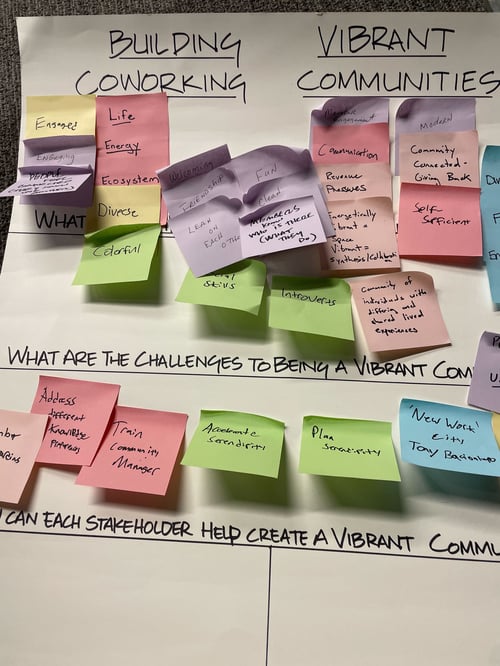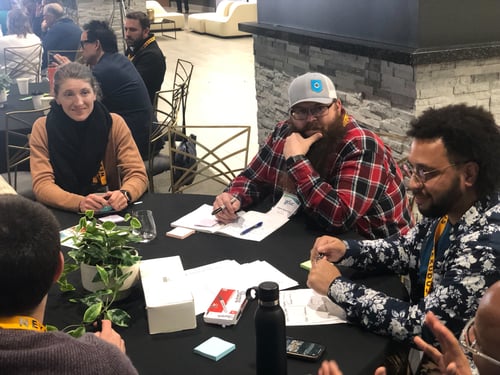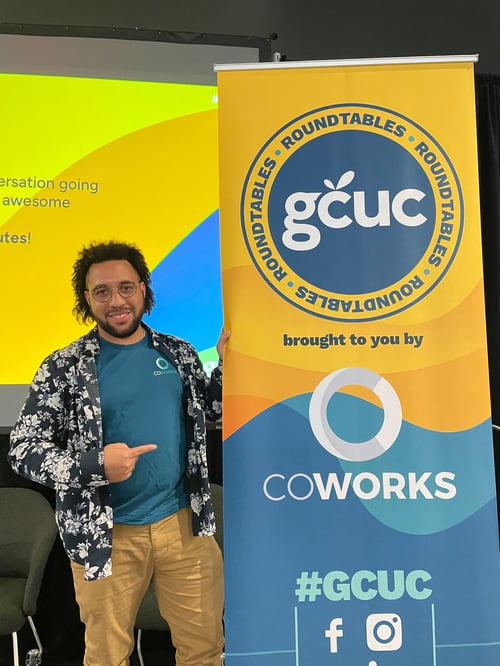If the attendees of GCUC 2024 were surprised to find a table full of sticky notes awaiting them, they didn’t let on. An arts and crafts type challenge seemed to suit everyone just fine.
But let’s take a step back. This month, the Global Coworking Unconference Conference (GCUC) in Salt Lake City was a hub of innovative ideas and passionate discussions about the future of coworking spaces. One of the highlights was a roundtable led by Coworks CEO DeShawn Brown, titled "Building Vibrant Coworking Communities." Brown's insights resonated deeply with participants, sparking conversations about resilience, engagement, and the evolving dynamics of coworking spaces post-COVID.
Participants were handed pens and stacks of sticky notes to share their thoughts on a central poster. And it seemed like a welcome break from the passive panel discussions and speaking tracks.

What is the essence of “vibrant?”
The roundtable kicked off with a crucial question: What does "vibrant" mean in the context of coworking? This question set the stage for a deep dive into the characteristics that define successful and lively coworking spaces.
Brown explained, "Vibrant to me means energy, life, ecosystem, diversity, engagement, and connection." This definition resonated with attendees, each of whom put their own thoughts on the notes and attached them to the poster — and who discussed how these elements contribute to a thriving environment where members feel valued and connected.
A common sentiment among the participants was the desire for coworking spaces to be lively and full of energy. "They mentioned wanting spaces to feel alive, interconnected, and populated—nobody wants a ghost town," said Brown. This highlighted a shared goal among coworking operators: creating spaces that are not just physically occupied but also rich in social and professional interactions.
Challenging the new normal
The discussion naturally pivoted to the challenges coworking spaces face in the wake of the COVID-19 pandemic. Many spaces are navigating a "new normal," where the engagement that once came naturally now requires more deliberate effort and strategy.

Brown pointed out that both new and established spaces are grappling with these changes. "The main theme seemed to be about new spaces coming in and thinking forward about creating active and vibrant spaces, while existing spaces were dealing with post-COVID engagement challenges," Brown noted.
The conversation also touched on personal connections and the integration of diverse community members. "A key focus was on diversity, with attendees wanting to ensure their communities were representative of the larger community as well as interconnected, with people knowing who each other are," Brown added. This aspect of community building is crucial for fostering a sense of belonging among members, which is more important than ever in today's fragmented world.
Overcoming social barriers
Another significant challenge discussed was the social skills gap that has emerged as more people return to physical workspaces after prolonged periods of remote work. Brown shared an anecdote that captured this issue: "For example, one participant shared how she teaches her kids to look people in the eyes, a skill lost in the virtual world." This highlighted how basic interpersonal skills need reaffirmation in the post-pandemic landscape.
Training and integrating new staff members also emerged as a pivotal theme. Many coworking spaces see frequent changes in personnel, which can disrupt the continuity of community engagement. "There was also a significant focus on training new staff to maintain a high level of engagement in coworking spaces, ensuring they connect people as effectively as before," said Brown. This is essential for keeping the community spirit alive, even as staff roles evolve.
Innovative solutions for engagement
The roundtable wasn't just about discussing problems; it also focused on actionable solutions. Brown emphasized the importance of strategic onboarding and continuous training for community managers. "We discussed solutions like onboarding members, training community managers, and planning serendipity to foster one-on-one connections," Brown explained. These strategies are designed to create more organic interactions among members, which can lead to a more vibrant community.
Brown also highlighted creative approaches to building smaller, more intimate groups within larger communities, such as the formation of an introvert club. "This helps cater to different member needs and ensures that everyone finds their comfortable space within the community," Brown remarked.
How tech builds community
An important takeaway from the roundtable was the role of technology in enhancing community engagement. Brown pointed out that many existing systems fall short in helping coworking spaces foster a sense of community.
"I emphasized that many current systems do not support these needs effectively, unlike what Coworks has available," Brown stated. Tools like member directories, regular member highlights, and event features can significantly enhance how members connect and interact.
The lasting impact of GCUC 2024
The insights shared by DeShawn Brown at GCUC 2024 provided valuable lessons for coworking operators everywhere.
Whether dealing with the challenges of re-engagement post-COVID or striving to create more interconnected and vibrant spaces, the ideas generated during this roundtable offer a roadmap for the future of coworking. As the industry continues to evolve, these discussions will play a crucial role in shaping how coworking communities thrive in an increasingly complex work environment.
